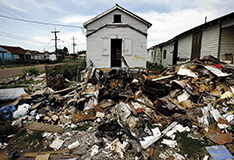Time to stop rebuilding a doomed city
September 21, 2008
After its recent brush with Hurricane Gustav, New Orleans again sparked controversy over the debate to rebuild.
The city, still dealing with the aftermath of Hurricane Katrina, sustained an estimated $10 billion in damages from Gustav, according to Louisiana Economic Development. Combined with the devastation caused by Katrina, the reaction to Gustav and the billions in damages are prime examples of why New Orleans should not rebuild.
Money aside, rebuilding the city does not make sense from a humanitarian standpoint. New Orleans will be hit again. Science shows, with certainty, that the city will be hit with a storm as catastrophic, if not more so, than Katrina. It is not a matter of if, but rather a question of when. Rebuilding the city in order for residents to finally return seems like sending them into the shark-infested waters with bait around their necks.
It is not logical to bring millions of people back into a city that is inevitably going to be struck again with immeasurable tragedy.
The decision to end rebuilding efforts would not be an easy one. The city has a charming history filled with jazz music, Mardi Gras, Creole food and Cajun culture. The old New Orleans was hard not to love. However, the decision to cease rebuilding efforts is the responsible one.
Geographically, New Orleans is perhaps the very worst place for a city to be located, as it sits 10 feet below sea level. But an intricate system of pumps and levees made habitation at such a low elevation possible for many years. However, climate change is causing the Earth’s oceans to rise, and New Orleans continues to sink. This means hundreds of miles of levees must be constantly maintained in order to keep the ocean out. The latticework of levees from the city to the sea leaves New Orleans on life support.
Although the levees made habitation possible, they have also kept the Mississippi River from flowing into swamps and wetlands. Channeling the Mississippi eventually destroyed much of the wetlands. This destruction has created an easy path to the city, increasing the potential for damage with each new storm.
Along with frail levees, rising ocean levels, dried-up wetlands and the geographical disadvantage of being 10 feet below sea level, New Orleans faces another major problem-the rising surface temperature of the Atlantic Ocean.
Hurricanes develop in tropical regions of the world with a sea-surface temperature of 82 degrees or warmer. But every year the sea-surface temperature is rising, which gives way to stronger, more frequent storms. The warmer the sea-surface temperature, the more powerful the storm will be.
Continuing to rebuild New Orleans is just like putting a bandage over a gaping wound. The wound is too big for the bandage, and despite best efforts, bandages do fall off.
In the end, the decision to walk away from rebuilding efforts does not come down to money or politics. It is not about ignoring a city, a demographic or a culture. The decision to end rebuilding comes down to science. It would be a much smarter decision for everyone involved if tax dollars were used to relocate the entire city instead of being wasted on rebuilding efforts. It is time for our government to make a tough and unpopular decision that will actually save lives in the end.








